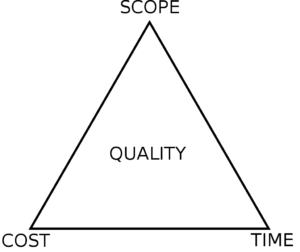Construction management (CM)
is a professional service that uses specialized, project management techniques and software to oversee the planning, design, construction and closeout of a project. The purpose of Construction management is to control the quality of a project’s scope, time / delivery and cost—sometimes referred to as a project management triangle or “triple constraints.”[1] CM is compatible with all project delivery systems, including design-bid-build, design-build, CM At-Risk and Public Private Partnerships. Professional construction managers may be hired for large to jumbo-scale, high budget undertakings (commercial real estate, transportation infrastructure, industrial facilities, and military infrastructure), called capital projects.

Project Managment Triangle

Safety and Site health management
Construction is a dynamic industry made up of several primary sectors, each with subsectors. Individual activities are diverse with workplaces and workforces that change constantly. In a typical project, there can be multiple employers and up to 10 different trades and trade unions on site. These multiple-employer and multiple-union workplaces are quite different from those in other industries.
The construction sector covers both large and small firms and includes unionized and non-unionized workplaces. The workforce includes contractors, sub-contractors, both part-time and temporary workers, family members and business owners.
Most construction contractors in Ontario are small- to mid-size employers. Many construction employers have fewer than eight employees. Some construction employers have more than 100 workers often working across several projects.
Amytiss Corp will continues to work actively with its health and safety partners and external stakeholders to control and, where possible, eliminate the top hazards in each sector. The partnership also promotes compliance and the development of a strong health and safety culture in the workplace.
Bid
- Re-bid (or re-tender) the construction of the project on a future date when the owner’s needs are met, such as when money becomes available and/or construction costs go down.
- Abandon the project entirely.
- Issue a work order to have the architect revise the design (sometimes at no cost to the Owner, if previously negotiated), so as to make the project smaller or more efficient, or reduce features or elements of the project to bring the cost down. The revised bid documents can then be issued again for bid (or re-tendered).
- Select a general contractor, such as the lowest bidder, or an experienced cost estimator to assist the architect with design changes aimed at cost reduction. This process is often referred to as value engineering. The revised bid documents can then be issued again for bid (or re-tendered).
The role of a contractor
Contractors are assigned to a construction project during the design for a constructibility review or once the design has been completed by a licensed architect or a licensed civil engineer. This is done by going through a bidding process with different contractors. As dictated by the project delivery method, the contractor is selected by using one of three common selection methods: low-bid selection, best-value selection, or qualifications-based selection.

Who we are
Our website address is: https://amytiss.co.
What personal data we collect and why we collect it
Comments
When visitors leave comments on the site we collect the data shown in the comments form, and also the visitor’s IP address and browser user agent string to help spam detection.
An anonymized string created from your email address (also called a hash) may be provided to the Gravatar service to see if you are using it. The Gravatar service privacy policy is available here: https://automattic.com/privacy/. After approval of your comment, your profile picture is visible to the public in the context of your comment.
Media
If you upload images to the website, you should avoid uploading images with embedded location data (EXIF GPS) included. Visitors to the website can download and extract any location data from images on the website.
Contact forms
Cookies
If you leave a comment on our site you may opt-in to saving your name, email address and website in cookies. These are for your convenience so that you do not have to fill in your details again when you leave another comment. These cookies will last for one year.
If you visit our login page, we will set a temporary cookie to determine if your browser accepts cookies. This cookie contains no personal data and is discarded when you close your browser.
When you log in, we will also set up several cookies to save your login information and your screen display choices. Login cookies last for two days, and screen options cookies last for a year. If you select “Remember Me”, your login will persist for two weeks. If you log out of your account, the login cookies will be removed.
If you edit or publish an article, an additional cookie will be saved in your browser. This cookie includes no personal data and simply indicates the post ID of the article you just edited. It expires after 1 day.
Embedded content from other websites
Articles on this site may include embedded content (e.g. videos, images, articles, etc.). Embedded content from other websites behaves in the exact same way as if the visitor has visited the other website.
These websites may collect data about you, use cookies, embed additional third-party tracking, and monitor your interaction with that embedded content, including tracking your interaction with the embedded content if you have an account and are logged in to that website.
Analytics
Who we share your data with
If you request a password reset, your IP address will be included in the reset email.
How long we retain your data
If you leave a comment, the comment and its metadata are retained indefinitely. This is so we can recognize and approve any follow-up comments automatically instead of holding them in a moderation queue.
For users that register on our website (if any), we also store the personal information they provide in their user profile. All users can see, edit, or delete their personal information at any time (except they cannot change their username). Website administrators can also see and edit that information.
What rights you have over your data
If you have an account on this site, or have left comments, you can request to receive an exported file of the personal data we hold about you, including any data you have provided to us. You can also request that we erase any personal data we hold about you. This does not include any data we are obliged to keep for administrative, legal, or security purposes.
Where we send your data
Visitor comments may be checked through an automated spam detection service.